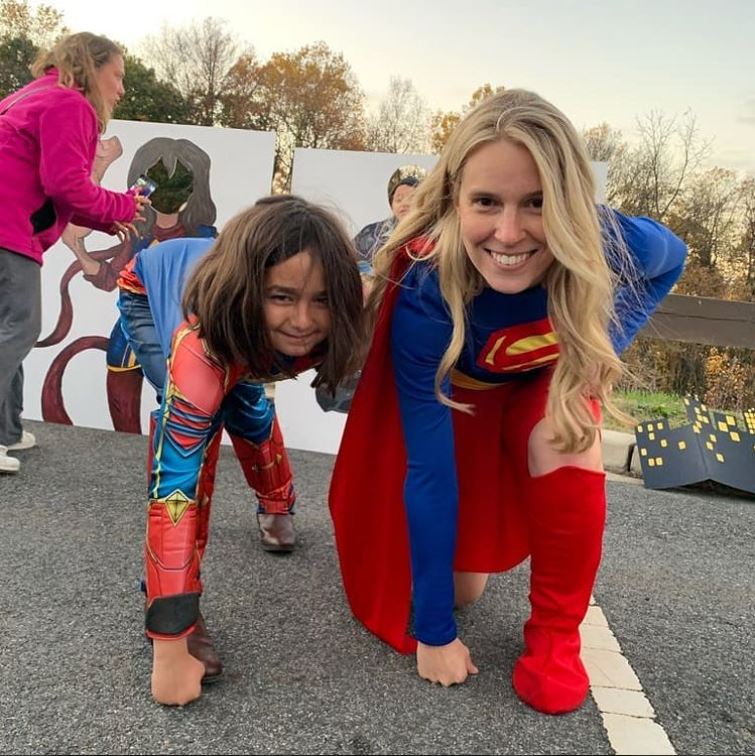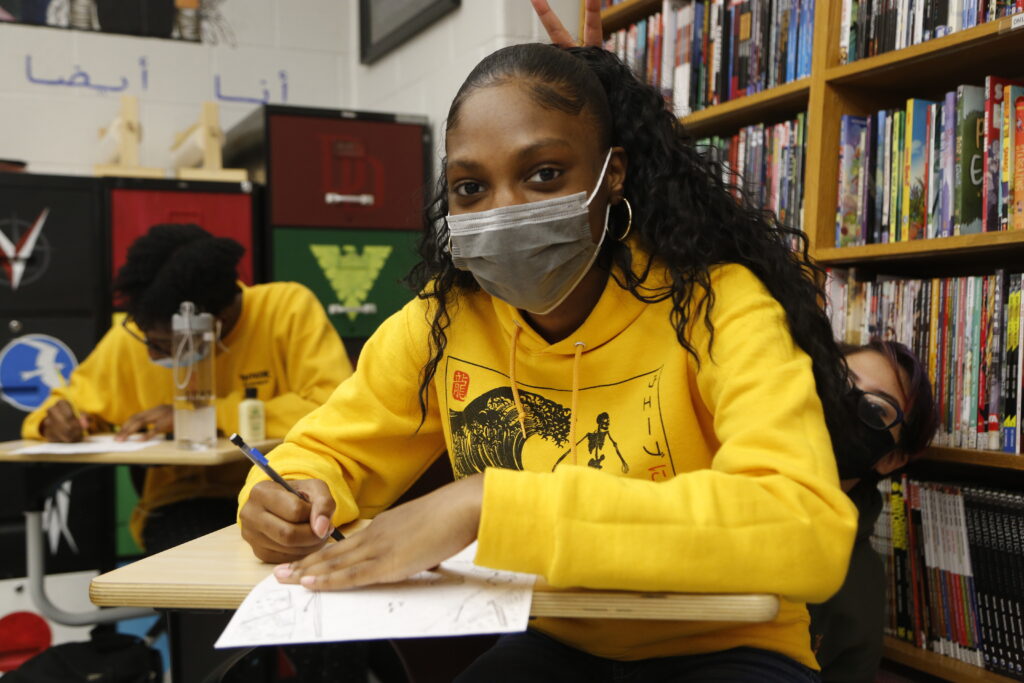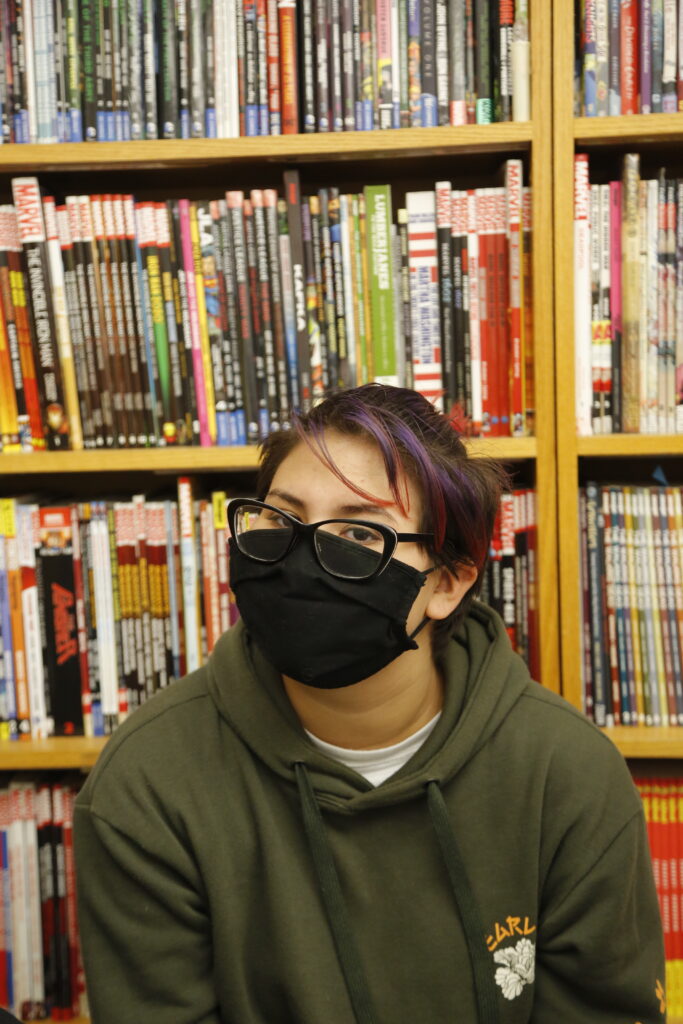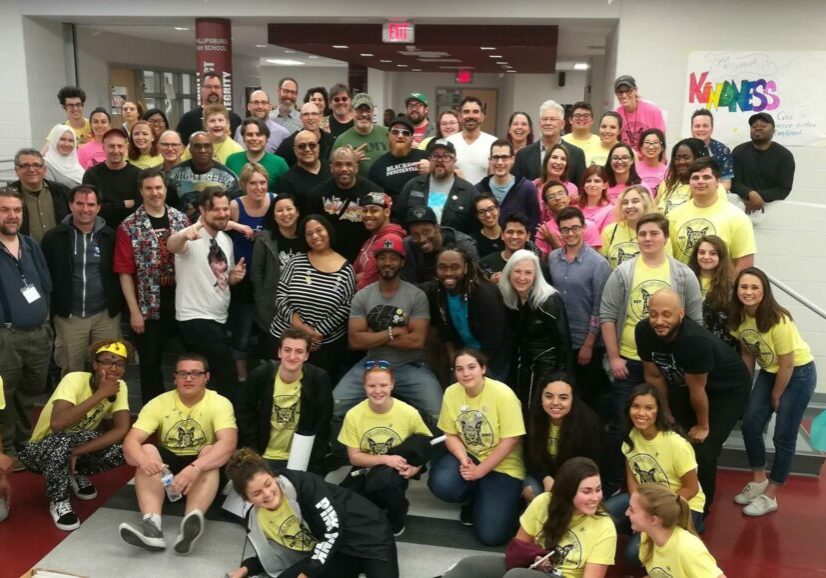By Kathryn Coulibaly
If any high school in New Jersey looks like the lair of superheroes, it’s Phillipsburg High School. Perched on a hill high above the Delaware River, it commands a view of the surrounding New Jersey and Pennsylvania countryside for miles. And it is here that Faith Roncoroni, 2021-22 Warren County Teacher of the Year, uses what was once considered an unconventional medium to challenge perspectives, engage her students and expand whose stories get told in a typical English classroom.

Faith Roncoroni in costume with a young Captain Marvel.
Roncoroni’s teacher origin story begins with her mother. Watching her, Roncoroni felt the excitement of bulletin boards and lesson plans and putting together her classroom every August. Roncoroni also understood from an early age that teaching wasn’t just about educating students; she saw her mother working with families and outside agencies. Her mother had begun her career as a Title I/basic skills teacher, then had her own classroom, and eventually worked in administration, giving Roncoroni a comprehensive view of education.
Another childhood influence plays a crucial role in Roncoroni’s transformation to educator. Growing up, Roncoroni’s family shared a love of reading comic books. In fact, that’s how her brother learned to read. They would visit comic book shops as a family and reading them was a community experience. With a massive family library to enjoy, she had access to some classics.
Challenging the canon
Comic books were not treated as a respected art form at that time, and certainly weren’t part of her high school curriculum. That changed when she got to Lehigh University.
“My first English professor, Seth Moglan, was a big inspiration,” Roncoroni recalled. “He was interested in analyzing texts and challenging the accepted canon. He was my first teacher who had us reading comics in our mainstream classroom, and I had never experienced that before.”
Other professors picked up what Moglan started—Professor Edward Whitley, who introduced Roncoroni to Indigenous literature, is someone she still shares comics with. “Professor Elizabeth Dolan let me read comics that address comics. I was even lucky enough to take an independent study with her and create my own illness comic.”
This project helped Roncoroni process her grandmother’s Alzheimer’s diagnosis and Roncoroni’s experiences as a caregiver through creative writing.
Even her anti-racist grad work with Dr. Jiménez explored comics like Gene Yang’s “American Born Chinese” and Saladin Ahmed’s “Miles Morales: Straight Out of Brooklyn.”
“All of these experiences led me to challenge the canon and what we had been led to believe was literature,” Roncoroni said. “I want my students to see how they can use literature to affirm themselves and others. Too often, these terms were used to keep people out and limit whose voices were valued.”
Roncoroni’s study continues, and she works to identify her own bias and prejudice so that she can correct it before it affects her students.
“It’s important that I’m aware of how I’m phrasing things, what kinds of assignments I’m giving students, what texts I’m teaching and what assumptions I may be making,” Roncoroni said.
Roncoroni teaches several levels of English as well as two different electives on comics.
“I love coming into class and talking about visual storytelling and being able to bring in elements from stereotypical literature like analyzing word choice, but the structures are really different,” Roncoroni said. “And what makes it really cool is that comics aren’t uncool anymore. Geek culture is now cool, and Marvel and DC made that happen with movies and TV shows.”
Roncoroni is excited to introduce her students to other storylines that may be unfamiliar to them. She loves teaching comics with stories that challenge the status quo, incorporate diverse characters, and focus on more relevant story lines.
“Comics have been addressing issues in history that a lot of educators have been uncomfortable teaching or have not felt well-versed in addressing, Roncoroni said. “But comics have brought different events and injustices to light. I think that’s powerful and a big part of why people have turned to this medium.”

A room brimming with stories and enthusiasm
Roncoroni’s classroom is full of bookshelves brimming with comic books, graphic novels, and manga, a comic form that originates in Japan. Vibrant artwork covers the walls. Students are encouraged to borrow and discuss books that interest them with Roncoroni who has seemingly read everything. Her enthusiasm for the subject could not be more obvious, right down to the comic-painted boots she wears, a gift from a former student.
One project the students particularly enjoy is a collaborative comic strip. One student begins a sequence with a drawing and a text. When time is called, it is passed to another student who adds their contribution, furthering the story. As it makes its way around the classroom, the story takes twists and turns the originator of the story had no way of predicting. Once time is called on the story, Roncoroni and the students gather to see the finished product and the amazing results, a combination of incredible artwork and innovative storytelling. It’s easy to see how engaged students are as they grab books from the shelves, read during down time and participate in the projects.
Roncoroni also uses video games to help students make connections and appreciate the timeless area of human storytelling.
“We analyze video games and look at how shots are framed, and we compare them to the different references [i.e., the comic book story lines that inspired the video games], and we look at how history has played a role in why the shot was framed that way,” Roncoroni said. “I like getting my students to think outside the stereotypical ‘great’ authors and move beyond what they’ve been told is ‘literature’ to really connect with texts. Whether you like reading poetry or short stories or novels, everyone likes some form of literature. You don’t need words for it to be literature, which is really awesome and opens the door for so many more people to connect with different forms.”
Interacting with comic creators
Roncoroni’s enthusiasm has led her to connect her students with comic creators such as Greg Anderson Elysee, author of the comic book series “Is’nana the Were-Spider,” based on the West African legend of Anansi the Spider.
“I love introducing my students to this series because it really challenges the anti-Blackness in society and is extremely empowering for my students,” Roncoroni said. “Like a lot of comic writers and artists, he has a strong connection to education. Many of these creators are teachers, have taught, or have educators in their families, so they are very receptive when teachers reach out to them. I’ve had comic creators speak to my students via Skype or Google Meets.”
When the COVID pandemic prevented in-person interaction with creators, Roncoroni was able to arrange for virtual meet-ups, which meant a lot to her students.
“I had a couple of creators talking with my students during COVID, which was exciting for us,” Roncoroni said. “The pandemic was really tough on students; it was incredible to have authors connect with my students like that.”
Students had gotten used to interacting with creators thanks to a huge project Roncoroni had been running since 2015. As the staff liaison for the school’s Anime Club, Roncoroni has helped run an extremely popular local Comic Con.
“My students can’t afford to buy tickets to Comic Con in New York City, and neither can most of the people who live in this area,” Roncoroni said. “So they work for an entire school year, and all summer long, to bring a Comic Con to our community. They’re emailing creators, they’re sending out monthly cards to encourage participation, they’re working with local comic book shops to get books and local restaurants to provide food. It’s inspiring to see how hard they work. In fact, they’re working so hard on the event, they don’t really get to enjoy it! But they’re making a positive change in the community and making sure that people have access to something special that makes people feel represented.”

Phillipsburg student Alyssa in front of one of the many bookshelves full of comics and graphic novels in Roncoroni’s classroom.
Students as superheroes
That’s not the only project Roncoroni’s students have taken on to make sure that underrepresented people have their voices heard.
“My students have gone to the DASACC, which is the local domestic violence agency in Warren County. There they work with the head of the county and state agencies to make sure documents are translated so they are accessible to Spanish-speaking communities,” Roncoroni said. “They have sat down with administration to make sure that tampon and pad dispensers are distributed throughout the school with free products. They’ve met with school nurses to make sure that the product that is ordered works for the students who will use them. My students are absolutely phenomenal. If anyone knows the high school students who are coming up right now, you cannot help but be blown away by how caring and aware they are.”
It seems clear that these students are writing their own superhero origin stories, and that Faith Roncoroni’s influence is playing an important part.
Kathryn Coulibaly is the associate editor of the NJEA Review and provides content and support to njea.org. She can be reached at kcoulibaly@njea.org.
Students speak out on comics in the classroom
“My dad collects comic books, and I got into it about 10 years ago. I like the different styles of art. I really didn’t like reading before, but I’ve read about 50 comic books now.”
Toni, 11th grade
“Using comic books makes me more engaged in English class. Ms. Roncoroni is my favorite teacher. More people should be into comics, even if you don’t like reading.”
Alyssa, 11th grade
“Comics are fun and I’m much more into fantasy than real life. I think comic books and graphic novels are good ways to study literature and make it fun.”
Blaze, 12th grade
“Manga and comics go hand-in-hand. The types of characters in Japanese manga are extremely varied. The characters are really interesting, and you get much more intense moral conflict.”
Winston, 11th grade
You don’t need a Bat Signal to connect with Faith
Roncoroni is eager to support other educators interested in incorporating comic books into their classroom or starting their own Comic Cons in their districts. She may be reached at roncoroni.faith@pburgsd.net.
